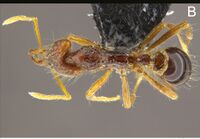Strumigenys anorak
| Strumigenys anorak | |
|---|---|

| |
| Scientific classification | |
| Kingdom: | Animalia |
| Phylum: | Arthropoda |
| Class: | Insecta |
| Order: | Hymenoptera |
| Family: | Formicidae |
| Subfamily: | Myrmicinae |
| Tribe: | Attini |
| Genus: | Strumigenys |
| Species: | S. anorak |
| Binomial name | |
| Strumigenys anorak Sarnat, Hita-Garcia, Dudley, Liu, Fischer & Economo, 2019 | |
Identification
Strumigenys anorak is a relatively large and highly distinctive rich reddish brown species with abundant flagellate and filiform hairs on its dorsal surfaces, a unique sculpture characterized by a smooth integument interrupted by deep irregularly sized and shaped pits, and the presence of a broad and conspicuous propodeal lamella. Additional characters for separating S. anorak from similar Fijian species are given in the notes for Strumigenys daithma. The species is represented by three specimens, two from Gau and one from Viti Levu, all between 400 and 475 meters and collected from extracted leaf litter.
Distribution
Distribution based on Regional Taxon Lists
Indo-Australian Region: Fiji (type locality).
Distribution based on AntMaps
Distribution based on AntWeb specimens
Check data from AntWeb
Countries Occupied
| Number of countries occupied by this species based on AntWiki Regional Taxon Lists. In general, fewer countries occupied indicates a narrower range, while more countries indicates a more widespread species. |

|
Biology
The species is represented by three specimens, two from Gau and one from Viti Levu, all between 400 and 475 meters and collected from extracted leaf litter.
Castes
Strumigenys X-ray micro-CT scan 3D model of Strumigenys anorak (worker) prepared by the Economo lab at OIST.
X-ray micro-CT scan 3D model of Strumigenys anorak (worker) prepared by the Economo lab at OIST.
Strumigenys FJ18. See on Sketchfab. See list of 3D images.
Nomenclature
The following information is derived from Barry Bolton's Online Catalogue of the Ants of the World.
- anorak. Strumigenys anorak Sarnat, Hita-Garcia, Dudley, Liu, Fischer & Economo, 2019: 12, figs. 7A, 9A, 9B, 11, 26, Model 1 (w.) FIJI.
Description
Worker. Measurements (n = 3): TL 3.18–3.40 mm, HL 0.79–0.87 mm, HW 0.54–0.59 mm, CI 68, MdL 0.35–0.36 mm, MI 41–45, SL 0.51–0.57 mm, SI 96, PW 0.37–0.40 mm, PI 68, FL 0.62–0.68 mm, FI 115, EL 0.08–0.09 mm. Color a polished reddish-brown with yellowish-brown appendages. Mandible long and linear with one preapical tooth; preapical tooth approximately as long as maximum mandible width. Dorsolateral head margin with abundant laterally projecting filiform and occasionally flagellate hairs. Apicoscrobal hair flagellate. Upper scrobe margin anterior to apicoscrobal hair with filiform hairs. Cephalic dorsum irregularly reticulate-punctate. Ground pilosity of cephalic dorsum simple and long. Pronotal humeral hair flagellate. Promesonotal dorsum with abundant projecting filiform apically curved hairs; mesonotum with at least one pair of longer flagellate hairs. Promesonotal dorsum and propodeal dorsum smooth and marked by laterally by deep and occasionally overlapping spongiform filled pits of irregular size and shape from small and circular to large and ovoid. Side of promesonotum smooth and marked with pits similar to those of dorsal surface. Mesopleuron, metapleuron and side of propodeum glassy smooth. Propodeal tooth short, narrowly triangular, subtended by a broad lamella with a convex posterior margin. Dorsal and ventral surfaces of hind femur with abundant erect filiform and subflagellate hairs. Dorsal surface of hind tibia with one filiform hair on basal portion and one subflagellate hair on apical portion. Dorsal surface of hind tarsus with three flagellate hairs. With petiole node in profile the dorsum of the node much longer than its short oblique anterior face; lateral spongiform lobe small; restricted to posterior margin of node. Dorsum of petiole node highly polished with scattered irregular shaped pits. Disc of postpetiole glassy smooth. Ventral lobe of postpetiole spongiform. First gastral tergite with erect flagellate hairs and long ground pilosity. Basigastral sculpture entirely absent.
References
- Sarnat, E.M., Hita-Garcia, F., Dudley, K., Liu, C., Fischer, G., Economo, E.P. 2019. Ready species one: Exploring the use of augmented reality to enhance systematic biology with a revision of Fijian Strumigenys (Hymenoptera: Formicidae). Insect Systematics and Diversity 3(6): 6; 1–43 (doi:10.1093/isd/ixz005).

